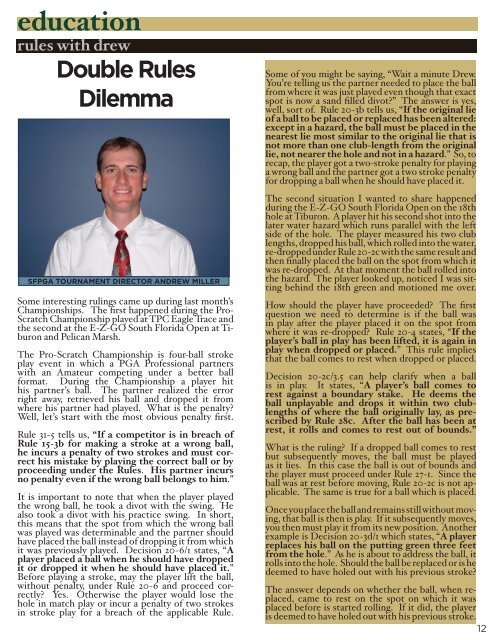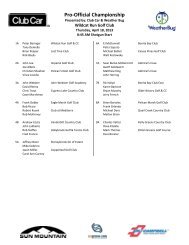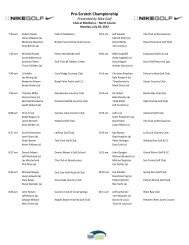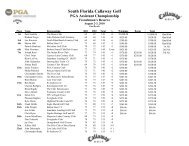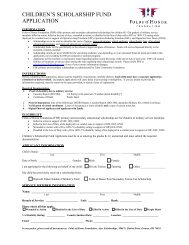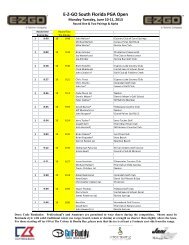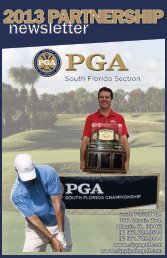TOPICS NEWSLETTER - South Florida PGA Golf
TOPICS NEWSLETTER - South Florida PGA Golf
TOPICS NEWSLETTER - South Florida PGA Golf
Create successful ePaper yourself
Turn your PDF publications into a flip-book with our unique Google optimized e-Paper software.
education<br />
rules with drew<br />
Double Rules<br />
Dilemma<br />
SF<strong>PGA</strong> TOURNAMENT DIRECTOR ANDREW MILLER<br />
Some interesting rulings came up during last month’s<br />
Championships. The first happened during the Pro-<br />
Scratch Championship played at TPC Eagle Trace and<br />
the second at the E-Z-GO <strong>South</strong> <strong>Florida</strong> Open at Tiburon<br />
and Pelican Marsh.<br />
The Pro-Scratch Championship is four-ball stroke<br />
play event in which a <strong>PGA</strong> Professional partners<br />
with an Amateur competing under a better ball<br />
format. During the Championship a player hit<br />
his partner’s ball. The partner realized the error<br />
right away, retrieved his ball and dropped it from<br />
where his partner had played. What is the penalty?<br />
Well, let’s start with the most obvious penalty first.<br />
Rule 31-5 tells us, “If a competitor is in breach of<br />
Rule 15-3b for making a stroke at a wrong ball,<br />
he incurs a penalty of two strokes and must correct<br />
his mistake by playing the correct ball or by<br />
proceeding under the Rules. His partner incurs<br />
no penalty even if the wrong ball belongs to him.”<br />
It is important to note that when the player played<br />
the wrong ball, he took a divot with the swing. He<br />
also took a divot with his practice swing. In short,<br />
this means that the spot from which the wrong ball<br />
was played was determinable and the partner should<br />
have placed the ball instead of dropping it from which<br />
it was previously played. Decision 20-6/1 states, “A<br />
player placed a ball when he should have dropped<br />
it or dropped it when he should have placed it.”<br />
Before playing a stroke, may the player lift the ball,<br />
without penalty, under Rule 20-6 and proceed correctly?<br />
Yes. Otherwise the player would lose the<br />
hole in match play or incur a penalty of two strokes<br />
in stroke play for a breach of the applicable Rule.<br />
Some of you might be saying, “Wait a minute Drew.<br />
You’re telling us the partner needed to place the ball<br />
from where it was just played even though that exact<br />
spot is now a sand filled divot?” The answer is yes,<br />
well, sort of. Rule 20-3b tells us, “If the original lie<br />
of a ball to be placed or replaced has been altered:<br />
except in a hazard, the ball must be placed in the<br />
nearest lie most similar to the original lie that is<br />
not more than one club-length from the original<br />
lie, not nearer the hole and not in a hazard.” So, to<br />
recap, the player got a two-stroke penalty for playing<br />
a wrong ball and the partner got a two stroke penalty<br />
for dropping a ball when he should have placed it.<br />
The second situation I wanted to share happened<br />
during the E-Z-GO <strong>South</strong> <strong>Florida</strong> Open on the 18th<br />
hole at Tiburon. A player hit his second shot into the<br />
later water hazard which runs parallel with the left<br />
side of the hole. The player measured his two club<br />
lengths, dropped his ball, which rolled into the water,<br />
re-dropped under Rule 20-2c with the same result and<br />
then finally placed the ball on the spot from which it<br />
was re-dropped. At that moment the ball rolled into<br />
the hazard. The player looked up, noticed I was sitting<br />
behind the 18th green and motioned me over.<br />
How should the player have proceeded? The first<br />
question we need to determine is if the ball was<br />
in play after the player placed it on the spot from<br />
where it was re-dropped? Rule 20-4 states, “If the<br />
player’s ball in play has been lifted, it is again in<br />
play when dropped or placed.” This rule implies<br />
that the ball comes to rest when dropped or placed.<br />
Decision 20-2c/3.5 can help clarify when a ball<br />
is in play. It states, “A player’s ball comes to<br />
rest against a boundary stake. He deems the<br />
ball unplayable and drops it within two clublengths<br />
of where the ball originally lay, as prescribed<br />
by Rule 28c. After the ball has been at<br />
rest, it rolls and comes to rest out of bounds.”<br />
What is the ruling? If a dropped ball comes to rest<br />
but subsequently moves, the ball must be played<br />
as it lies. In this case the ball is out of bounds and<br />
the player must proceed under Rule 27-1. Since the<br />
ball was at rest before moving, Rule 20-2c is not applicable.<br />
The same is true for a ball which is placed.<br />
Once you place the ball and remains still without moving,<br />
that ball is then is play. If it subsequently moves,<br />
you then must play it from its new position. Another<br />
example is Decision 20-3d/1 which states, “A player<br />
replaces his ball on the putting green three feet<br />
from the hole.” As he is about to address the ball, it<br />
rolls into the hole. Should the ball be replaced or is he<br />
deemed to have holed out with his previous stroke?<br />
The answer depends on whether the ball, when replaced,<br />
came to rest on the spot on which it was<br />
placed before is started rolling. If it did, the player<br />
is deemed to have holed out with his previous stroke.<br />
12


